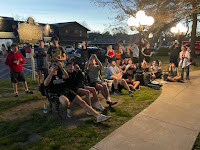 |
| Entering Trona from the South (c) Lisa R. Pruitt 2024 (February) |
 |
| Southwest of Trona, near Searles Valley industrial infrastructure (c) Lisa R. Pruitt 2024 |
The ratio of median home prices to household income is less than 2 to 1, compared to nearly 10 to 1 in the rest of the state.
 |
| Trona, California (c) Lisa R. Pruitt 2024 |
In the Searles Valley, the median household income was $54,000 in 2022, well below the statewide average of $92,000, according to census data. The poverty rate, however, was nearly 20%, far exceeding California’s 12% overall rate.
Sonney Berri, a real estate agent in Trona, has seen an uptick in prices since the COVID-19 pandemic, a trend he attributes to homeowners who previously lived close to city centers and sold their homes to buy properties in this unincorporated community in San Bernardino County.
 |
| Trona Senior Center (c) Lisa R. Pruitt 2024 |
Castleman also writes of the town's longer-term history:
Old Guesthouse Museum, (c) Lisa R. Pruitt 2024
Trona, a “desolate area that was very much thriving back in the ’50s and ’60s,” was littered with abandoned homes after plants closed decades ago, said Berri, 49. Now, “people are fixing them up and making the community better,” he said.
Trona’s heyday was in the early 1900s, when it was a company town, established in 1914 and operated by the American Trona Corp. Early on, a central building housed many workers and all the town’s businesses, including a “pool hall, a barber shop, post office, library, grocery and department store,” according to the Searles Valley Historical Society.
 |
| Former dollar store is now the Trona Food Bank (c) Lisa R. Pruitt 2024 |
The story features some rich quotes from residents, like that of 80-year-old Ann Epperly, who said she likes being able to "ride horses all over town."
It also explains how Trona's star waned as its industrial importance lagged and as Ridgecrest, 25 miles away, grew.
Ridgecrest is now home to the closest Walmart. I noticed that even a dollar store had closed--and been reappropriated as the Trona Food Bank. The former pharmacy was boarded up, as was a relatively new looking Shell station.
On the other hand, the town boasted a spiffy new, but spartan, branch of the San Bernardino County Library. The Senior Center looks robust; boxes of produce were stacked outside it when I passed through on a Saturday morning, when the center was closed. San Bernardino County offices, including a court, were just a street or two off Highway 178, as was the U.S. post office.
Here's what Castleman reports about the eight other California towns where median home values are in the $150K range:
Some of the state’s lowest median home values — as low as $114,000 —are located near the Oregon border, in the towns of Dorris, Macdoel and Tulelake. Each town is home to less than 1,000 people and set amid agricultural fields.
Herlong, located along the border with Nevada, 90 miles north of Lake Tahoe, is another town with a low median home value. It’s an army town named after a World War II-era captain and home to a military storage facility.
San Bernardino County Library, Trona Branch
In Southern California, five towns round out the group of nine: Boron, Yermo, Hinkley, Johannesburg and Trona. Surrounded by desert, most were built up around the mining industry and all have lost population in recent decades.
 |
| Sign near Mohave (c) Lisa R. Pruitt 2024 (February) |
The town of Boron is named for the element found in borax, and Hinkley is known for a groundwater contamination lawsuit that inspired the movie “Erin Brockovich.”










